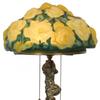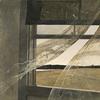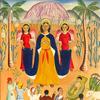Birds of a Feather: Joseph Cornell's Homage to Juan Gris Opening January 23 at The Met
- NEW YORK, New York
- /
- December 12, 2017
On October 22, 1953, Joseph Cornell wrote in his diary: "Juan Gris/Janis Yesterday." He was referring to the previous day's outing, when, on one of his frequent trips to the gallery district in midtown Manhattan, Cornell visited the Sidney Janis Gallery on East 57th Street. Among a presentation of approximately 30 works by modern artists, one alone captivated Cornell—Juan Gris's celebrated collage The Man at the Café (1914), which is now a promised gift to the Museum as part of the Leonard A. Lauder Cubist Collection. This shadowy profile of a fedora-topped man immediately inspired Cornell to begin a new series: some 18 boxes, two collages and one sandtray created in homage to Juan Gris, whom he called a "warm fraternal spirit." Completed over a period of 13 years, Cornell's series of Gris shadow boxes is more extensive in number than any other that the artist openly dedicated to one of his admired luminaries of stage, screen, literature, or the visual arts. The main protagonist of Cornell's Juan Gris series is a bird—the great white-crested cockatoo—specifically, an image taken from a 19th-century print of the species that Cornell repeatedly used along with Photostats or silhouettes of the bird's form to explore the fascinating shadows that Gris produced in his own practice. At The Met, the exhibition Birds of a Feather: Joseph Cornell's Homage to Juan Gris will reunite for the first time nearly a dozen boxes from Cornell's Gris series together with the Cubist masterpiece, The Man at the Café. Birds of a Feather: Joseph Cornell's Homage to Juan Gris inaugurates a series of dossier exhibitions under the auspices of the Leonard A. Lauder Research Center for Modern Art at The Metropolitan Museum of Art.
When he began the Gris series in 1953, Cornell was an established artist, two decades into his career. His shadow box assemblages—a genre he is credited with pioneering—were exhibited regularly in major galleries and museums, and acquired by collectors and museums for their permanent collections. Cornell gathered his banal yet evocative materials during his forays in New York City or Long Island. His sources were many and varied; he made his assemblages from old journals and French history textbooks, postage stamps, fishing tackle, cordial glasses, clay pipes, and "flotsam and jetsam" to use his words. From these disparate fragments, Cornell wove together concepts, subjects, and lives that fascinated him. The complex network of references contained in each box often obscures, if not conceals, the artist's intended theme or subject. For instance, in his Gris series, Cornell incorporated reproductions of Gris's works into only one box, as well as in two collages and the one sandtray. Without these reproductions and the inscriptions Cornell made on some of the constructions, most of the works in his Gris series would be indistinguishable from those in his Aviaryand Hotelseries from around the same time—although for his homages to Gris he used the great white-crested cockatoo exclusively. Few viewers would have known about Cornell's extensive notes found in his diaries and his Grisdossier, a working source file in which he stored materials for inspiration or later use. Cornell's research on Gris included the acquisition of biographical publications and reviews on the Spanish-born artist, and he bolstered his knowledge of Gris and his art through conversations with artist friends such as Marcel Duchamp and Robert Motherwell. In The Man at the Café, Gris worked in oil paint and pasted newsprint to present a mysterious male figure reading a newspaper, which obscures his face. The shapes of the man's stylized fedora and its prominent black shadow cast against the café wall held particular fascination for Cornell. For the central figure of his Gris series, Cornell selected a white cockatoo to contrast with the dramatic blacks, but he also embedded a reference to Gris's shadow play and the fedora's silhouette. Indeed, the bird, or its distinctive silhouette, appears in all but two of the boxes, with Cornell mimicking the relationship between positive and negative space by pasting the bird print to a wood cutout, outlining it, or echoing its contours with black paper.
Although Gris remained the initial catalyst for the series, Cornell also incorporated allusions to his own passions and pastimes as revealed in the foreign language texts, hotel advertisements, and maps. An aficionado of ballet and opera, Cornell attended performances in New York City and contributed illustrations to the Dance Index, a periodical edited by New York City Ballet co-founder Lincoln Kirstein in the 1940s. The white, feathered and tulle costumes of the principals dancing Swan Lake and La Sylphide reminded him of birds. Cornell was also enamoured with the nineteenth century, the era of the romantic ballet and bel canto singing, and wove these birds of song and stage into the Gris series as well.
As part of its mission to ensure the ongoing study of modern art with a particular focus on Cubism, the Leonard A. Lauder Research Center offers fellowships, lectures, and other programs to support new scholarship on the Leonard A. Lauder Cubist Collection and other 20th-century art. Each dossier exhibition will be related to a work or group of works from the Collection. Birds of a Feather: Joseph Cornell's Homage to Juan Gris and future projects in the series are intended to provide a deeper context for understanding Cubism, its protagonists, and greater influences, to contribute exceptional scholarship, and to offer a fresh approach to the subject of looking and thinking about modern art.
The exhibition is curated by Mary Clare McKinley, an independent art historian based in London and former Assistant Curator in the Leonard A. Lauder Research Center for Modern Art, The Metropolitan Museum of Art.
A catalogue, made possible by the Leonard A. Lauder Research Center for Modern Art, accompanies the exhibition and contains a major essay, written by McKinley, and the first-ever documentary catalogue of Cornell's Gris series.
The exhibition is featured on The Met website











100x100_c.jpg)



